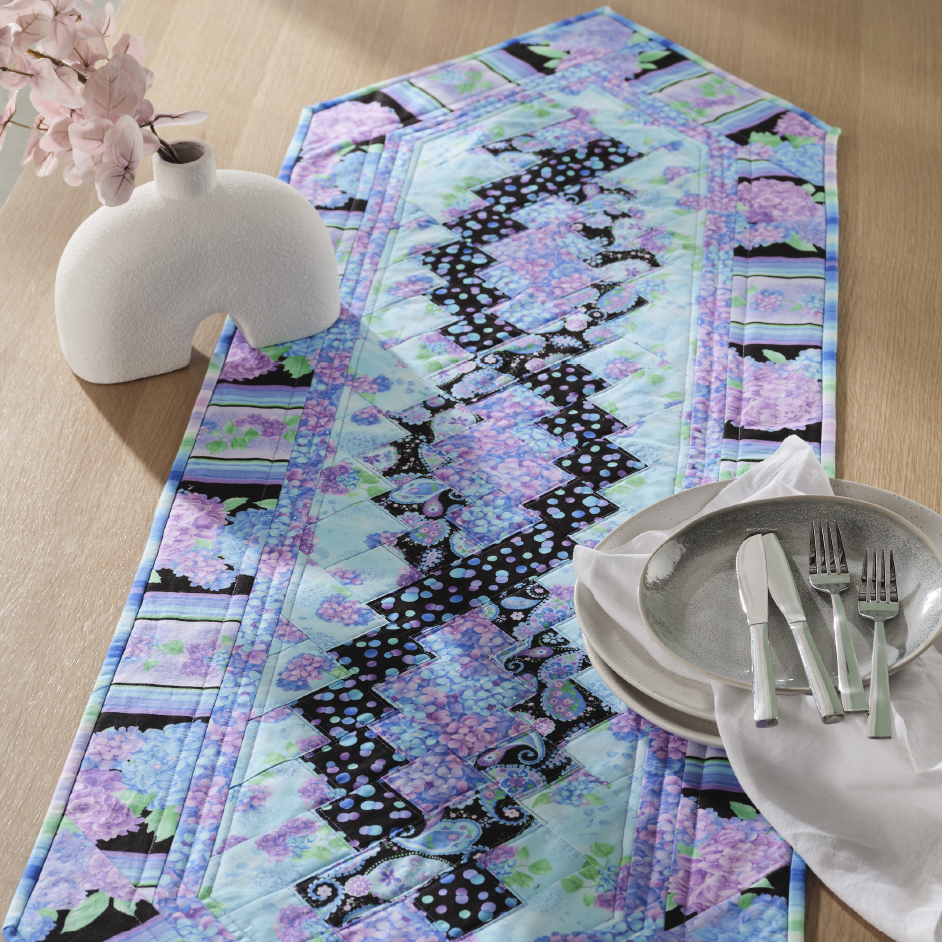 | ||
| Your browser is not supported. | ||
|
Please browse our site using any of the following options:
| ||
HYDRANGEA TABLE RUNNER

Level: Medium
What you'll need:
- Fabrics are from 'Hydrangea' range
- 30cm fabric A - multi petals
- 20cm fabric B - black dots
- 20cm fabric C - black paisley
- 40cm fabric D - small aqua hydrangeas
- 40cm fabric E - 11" multi stripe
- 30cm fabric F - multi stripes (for binding)
- 1.7m fabric G - large black hydrangeas (for backing)
- 60cm x 1.7m Legacy cotton/bamboo batting
- Matching Gutermann 100% cotton thread
- Rotary cutter, mat & quilters rulers
- Quilting pins, tape measure
- Scissors, seam ripper
- Pilot frixion marker
- Hand sewing needle
- Sewing machine with 1/4" foot & walking foot
All fabrics should be 100% cotton, washed & pressed.
1/4" seam allowance used throughout unless otherwise indicated.
Read all instructions carefully before commencing the project.
Instructions
Cutting
All strips are cut across the width of fabric unless otherwise stated.
- From fabric A cut - 2 x 2 1/2" strips, crosscut into 8 x 2 1/2" squares, 6 rectangles 1 1/2" x 2 1/2", 3 rectangles 4 1/2" x 2 1/2", 3 x 1 1/2" strips for inner border.
- From fabric B cut - 2 x 2 1/2" strips, crosscut into 13 x 2 1/2" squares, 2 rectangles 6 1/2" x 2 1/2".
- From fabric C cut - 2 x 2 1/2" strips, crosscut into 13 x 2 1/2" squares, 2 rectangles 6 1/2" x 2 1/2".
- From fabric D cut - 5 x 2 1/2" strips, crosscut into 13 x 2 1/2" squares, 4 rectangles 3 1/2" x 2 1/2", 15 rectangles 4 1/2" x 2 1/2", 6 rectangles 5 1/2" x 2 1/2", 2 rectangles 6 1/2" x 2 1/2", one rectangle 8 1/2" x 2 1/2".
- From fabric E cut - 4 x 3 1/2" strips down the length of the fabric for outer border.
- From fabric F cut 4 x 2 1/2" strips for binding.
Table Runner Top
Note - the table runner is worked in 7 sections starting at the bottom.
Step 1 - Refer to the design layout in the finished image on the front of this sheet to arrange squares and rectangles into the 7 sections.
Step 2 - Section 1, sew together 2 1/2" squares D-B-A-D, sew a 6 1/2" C rectangle to a 2 1/2" D square, sew together 2 1/2" squares A-B to a 4 1/2" D rectangle, sew together a 1 1/2" A rectangle, a 2 1/2" B square and a 4 1/2" D rectangle, sew a 2 1/2" B square to a 4 1/2" D rectangle. Press seams in each strip in opposite directions.
Step 3 - Using strips made in step 1 sew together as follows to complete section 1: an 8 1/2" D rectangle, D-B-A-D strip, C-D strip, A-B-D strip, 1/2A-B-D strip, B-D strip, 4 1/2" D rectangle, 2 1/2" D square. Press seams in one direction.
Step 4 - Section 2, sew together a 5 1/2" D rectangle, a 2 1/2" C square, a 4 1/2" A rectangle, a 2 1/2" B square and a 4 1/2" D rectangle. Press seams in one direction.
Step 5 - Sew section 1 to section 2 matching the centre of the 4 1/2" A rectangle with the centre of the 1 1/2" A rectangle. Note - seams do not align and the 4 1/2" D rectangle on the right-hand end of section 2 will extend over the end of 2 1/2" D square at the end of section 1.
Step 6 - Section 3 is assembled using the same method as for section 1.
Step 7 - Section 4 is assembled using the same method as for section 2.
Step 8 - Sew section 3 to section 4 matching the centre of the 4 1/2" A rectangle with the centre of the 1 1/2" A rectangle.
Note - Seams do not align and the 4 1/2" D rectangle on the right-hand end of section 4 will extend over the end of 2 1/2" D square at the end of section 3.
Step 9 - Section 5 is assembled using the same method as for section 1.
Step 10 - Section 6 is assembled using the same method as for section 2.
Step 11 - Sew section 5 to section 6 matching the centre of the 4 1/2" A rectangle with the centre of the 1 1/2" A rectangle. Note - seams do not align and the 4 1/2" D rectangle on the right-hand end of section 4 will extend over the end of 2 1/2" D square at the end of section 5.
Step 12 - Section 7 is assembled using the same method as for section 1.
Step 13 - Sew sections 1-2 to sections 3-4 matching the centre of the 4 1/2" A rectangle with the centre of the 1 1/2" A rectangle. Sew sections 5-6 to section 7 matching the centre of the 4 1/2" A rectangle with the centre of the 1 1/2" A rectangle. Sew sections 1-2-3-4 to sections 5-6-7 matching the centre of the 4 1/2" A rectangle with the centre of the 1 1/2" A rectangle. Press well.
Step 14 - To straighten sides use your long ruler and a Frixion pen to mark the down the centre. Mark on each side 5 1/4" from the centre and rule a line. Using rotary cutter and ruler trim off excess fabric. Remember Frixion pen lines can be removed with a quick press.
Step 15 - Inner border sew a 1 1/2" fabric A strip to each side, press seam towards border and trim off ends. Starting at bottom line up end of strip with straight edge of point. Sew in place trim off excess fabric and press seam towards border. Repeat for remaining 3 edges of points.
Step 16 - Outer border sew a 3 1/2" fabric E strip to each side, press seam towards border and trim off ends. Starting at bottom line up end of strip with straight edge of point. Sew in place trim off excess fabric and press seam towards border. Repeat for remaining 3 edges of points.
QUILTING
Step 17 - Layer the backing, batting and table runner top and baste together. Quilt as desired then trim off excess backing and batting.
Step 18 - Join the 4 x 2 1/2" fabric F binding strips on the bias to make one long strip. Press in half lengthwise and bind mitering corners.




